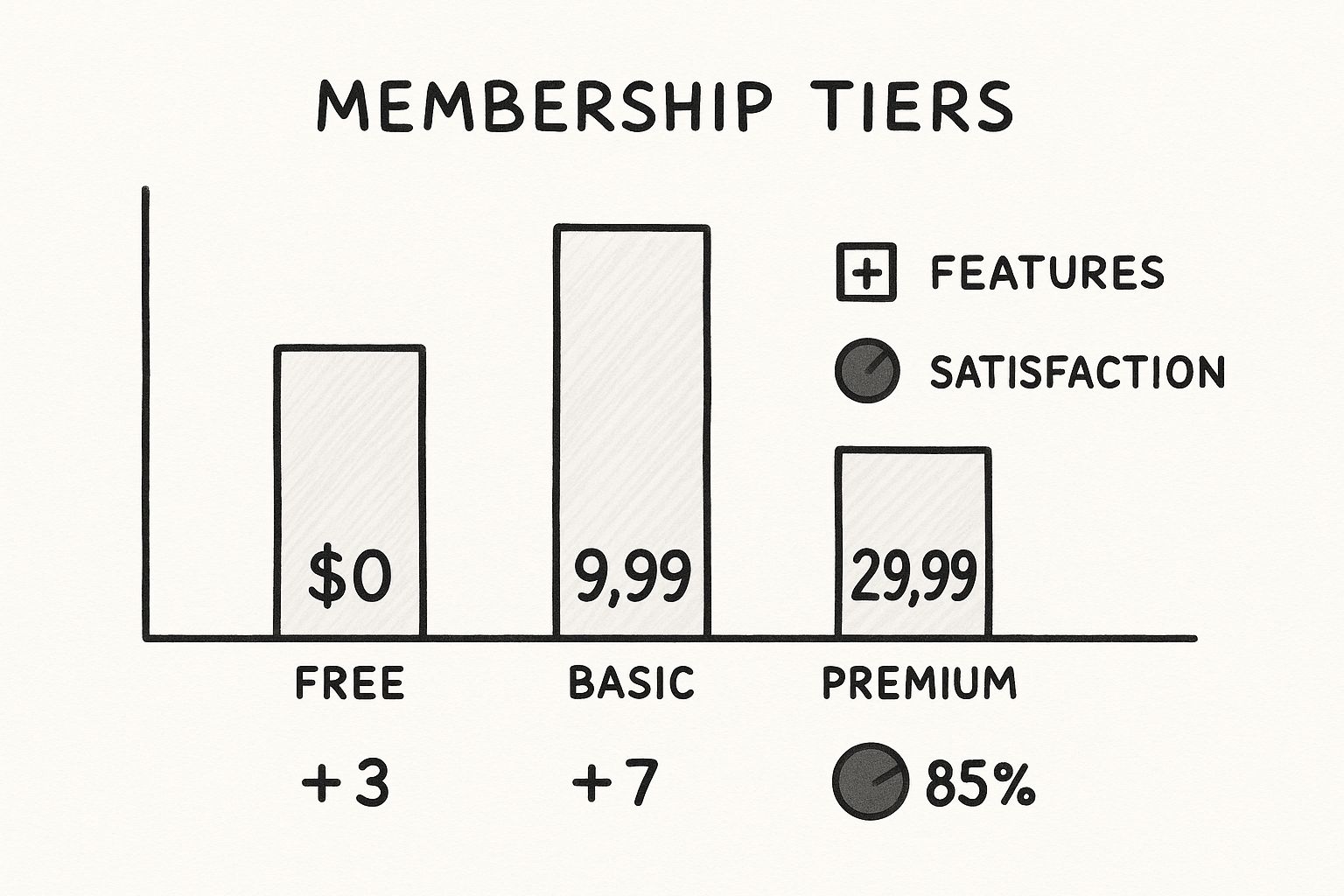July 20, 2025

Think of it this way: anyone can wander through a city and look at the sights. But someone who lives there—a resident—has the keys to the best neighborhoods, gets invited to local events, and feels a real sense of belonging. That's the essence of platform membership. It’s about consciously shifting from treating people as one-time visitors to welcoming them as valued residents of your digital world.
A platform membership is so much more than just giving someone a login. It’s about cultivating a genuine community where people feel invested in what you're building together. It’s the difference between someone buying a single ticket to a concert and someone joining the official fan club. The fan club member doesn't just get the music; they get exclusive content, early access to new releases, and a direct line to other people who share their passion.
This model completely changes the dynamic. It stops being a one-way street where you provide a service and a user consumes it. Instead, it becomes a vibrant, two-way exchange. Members don't just use your features or read your content; they actively contribute, interact with each other, and make the entire platform better for everyone. Their participation creates a powerful network effect, making your platform the go-to place in your niche.
At its heart, a strong membership platform is designed to turn those brief, transactional moments into long-term, loyal relationships. This is more important than ever. The number of social media users worldwide is on a steady climb, projected to hit an incredible 5.42 billion by 2025. You can dig into the full user growth report from Statista to see the trend for yourself. This explosion in connectivity highlights a deep-seated human need for community—a need that membership models are perfectly built to meet.
What is a Platform Membership?It’s a model where you give users ongoing access to your platform's core value—be it content, community, tools, or services—in exchange for their consistent commitment. That commitment might be a subscription fee, but it can also be their active participation or content contributions.
This commitment is what turns a passive user into an active advocate. These are the people who will give you honest feedback, tell their friends about you, and stick with you even when a new competitor pops up. That kind of loyalty is the ultimate business advantage, creating a protective moat around your platform that's incredibly difficult for anyone else to build. You’re no longer just selling a product; you're building a community that people are proud to be a part of.
A great membership platform doesn't happen by accident. It's built with purpose, piece by piece, on a solid foundation of key features. Think of it like building a city people actually want to live in, not just pass through. You need more than just streets and buildings; you need an infrastructure that fosters a real community.
These components are your blueprint. Each one has a specific job, but they all need to work together to create an experience that makes members feel connected and valued. Get these right, and your platform will evolve from a simple service into a thriving, self-sustaining ecosystem.

To create a platform membership that people can't resist, you need to nail these four foundational pillars. These are the non-negotiables that users expect and that keep them coming back for more.
Once you have a space for members to gather, you need ways for them to connect with each other and for the platform to become sustainable. These next two building blocks are absolutely crucial for creating a dynamic environment that lasts.
There's a common saying in this space: "People join for the content, but they stay for the community." This really hits on the importance of moving beyond just pushing out information and instead fostering real, multi-directional conversations among your members.
The biggest platforms have mastered this. Facebook, for instance, has over 3.065 billion monthly active users, and its largest demographic (31.1%) is the 25-34 age group—a clear sign of how powerful connected communities are. You can dig into more social media demographic insights from Sprout Social to see these trends for yourself.
Platforms like Patreon are brilliant at combining these elements. They give creators the tools to manage tiered benefits while helping them build a strong community around their exclusive content. In the professional world, LinkedIn uses its robust profiles and specialized groups to create a powerhouse network. By understanding these building blocks, you can craft a platform membership that doesn't just attract users, but turns them into loyal residents of your digital world.
Choosing the structure for your platform membership is one of the most important calls you'll make. There's no magic bullet here; the best choice is deeply tied to who your audience is, what you're offering them, and what your long-term business goals are.
Think of it like setting up a shop. A high-end, exclusive boutique has a completely different business model and customer experience than a massive, open-to-all warehouse store. The model you pick will directly shape everything from how you attract users to how predictable your revenue is. It's all about matching your strategy to the experience you want to create.
Most successful platforms build their strategy around one of four fundamental models. Each has its own set of perks and potential pitfalls, so it's crucial to understand what you're getting into before you lock in a decision.
The Free Model: This is all about getting as many people through the door as possible. Access is wide open, with the goal of building a huge user base fast. It’s a great fit for platforms that rely on the network effect—the more people that join, the more valuable it becomes for everyone. The big hurdle? Figuring out how to make money later, which usually involves ads or selling data insights.
The Freemium Model: A really popular hybrid approach. Freemium gives users a solid set of core features for free but keeps the best, most powerful tools behind a paywall. This is a fantastic way to let people see and feel your platform's value for themselves, creating a natural incentive to upgrade. The trick is to make the free version useful enough to keep people around, but not so good that they never feel the need to pay.
The Subscription Model: This is the classic "gym membership" of the online world. Members pay a recurring fee, usually monthly or annually, for continuous access to your content, community, or tools. This model is a gold standard for creating predictable revenue and building lasting relationships. The success of a subscription really boils down to one thing: consistently delivering enough value to keep people from canceling.
The Transactional Model: Think of this like a pay-as-you-go arcade. Instead of a flat fee, users pay for specific things—downloading a single guide, attending one webinar, or using a specific feature. This lowers the barrier to entry since people only pay for what they use. On the flip side, it can make your revenue stream feel a lot less predictable from month to month.
This visual shows how different membership tiers can influence what features users get and how happy they are with the platform.

As you can see, member satisfaction tends to climb right alongside the price and the number of features available. It’s a clear signal that people see the value in paying for more robust access.
To help you visualize the trade-offs, here’s a quick breakdown of how these four models stack up against each other.
Ultimately, this table is a guide. The best platforms often find ways to blend these models or evolve them over time as their community and offerings change.
To land on the right model, you have to get inside your members' heads. What do they really value? Are they looking for a deep, ongoing community connection, or do they just need a quick solution to a specific problem?
The most successful platforms don't just pick a model off a shelf; they build a value exchange that feels fair and compelling to their specific audience. This alignment is the foundation of a sustainable membership program.
If your core offering is a vibrant, active community, a subscription model makes a lot of sense—it ensures everyone is invested. On the other hand, if you provide a library of distinct digital assets, a transactional or freemium model might be a better fit.
For a deeper look into what it takes to build a thriving community hub, you can learn more about what makes a membership platform successful and how to keep it growing.
A successful platform membership is so much more than a simple gatekeeper for content; it's the very heart of a thriving digital community. What really separates a bustling online ecosystem from a digital ghost town is the ability to spark genuine loyalty and keep people coming back. It’s not about forcing them to participate, but making it feel rewarding, meaningful, and part of who they are.
Top-tier platforms nail this by creating a powerful sense of belonging and progress. They turn passive onlookers into active contributors by giving members a real stake in the community's success. Just think of Reddit's karma system—it's a simple but brilliant way to reward users for valuable contributions, giving them status and a real sense of ownership. Suddenly, lurking isn't enough; contributing is the goal.
The most compelling platforms all run on a simple principle: reciprocal value. Members feel their time and contributions are seen and rewarded, which naturally encourages them to invest even more. YouTube has mastered this model, effectively turning its content creators into business partners.
Here’s a look at YouTube's homepage, which uses powerful personalization to keep users hooked by showing them content that perfectly matches their viewing history.

This kind of personalization creates an incredibly sticky experience, making it the default destination for video. By offering sophisticated monetization tools—from ad revenue sharing to channel memberships—YouTube fuels a constant stream of high-quality content that keeps viewers glued to their screens. It's a self-sustaining loop of engagement that has cemented its dominance.
In fact, YouTube leads all social media platforms in active usage. Its active user base is roughly 16% larger than WhatsApp, its closest competitor, according to recent Android activity data. Considering Android powers nearly 74% of smartphones globally, that statistic paints a vivid picture of its immense influence. You can discover more about top social platform trends from Datareportal.
Beyond huge monetization models, several key tactics can dramatically boost member interaction and loyalty. These strategies all focus on making the member experience dynamic and personally relevant.
The old saying, "They join for the content, they stay for the community," has never been more true. A vibrant community turns a membership from a simple transaction into a vital part of a user's daily life, making it incredibly "sticky."
Here are three proven strategies you can put into action:
By weaving these elements into your platform, you transform it from a static library of content into a living, breathing community. For a deeper dive into building an active and loyal base, check out our complete guide to powerful community engagement strategies. These are the secrets to turning sign-ups into true fans.
Taking a great idea for a membership and turning it into a living, breathing program can feel like a massive undertaking. It's easy to get overwhelmed. But if you break it down, you can move from ambition to reality one step at a time. This blueprint lays out the essential stages, guiding you from that initial spark of an idea all the way to welcoming your first paying members.
Think of it like building a house. You wouldn't just start mixing concrete without a set of architectural plans, right? The same goes for a platform membership. You need a solid strategy in place long before you worry about the website or the welcome emails. Getting this part right from the start helps you sidestep common mistakes and builds a foundation that can actually support long-term growth.
First things first. You have to nail down the answer to one simple, but crucial, question: Why should someone join? This is your unique value proposition (UVP), and it's the absolute heart of your membership. It’s the promise you're making about the specific value and transformation people will get when they sign up.
Are you offering exclusive content they can't get anywhere else? A tight-knit community of peers? Access to premium tools, or maybe direct one-on-one time with experts? You have to be crystal clear on this. A vague UVP creates a muddled platform that tries to be everything to everyone, and ultimately, feels special to no one.
A strong value proposition isn't just a laundry list of features. It’s a compelling story that taps into what your audience truly needs or wants, making your membership feel like a can't-miss investment in themselves.
Once you’ve got this locked in, your UVP becomes your North Star. It will inform every other decision you make, from what you charge and how you market it to which features you build next.
With your value proposition clearly defined, it's time to get practical. You're now facing two big decisions: what technology will power your platform, and how will you actually launch it?
1. The Tech Stack Dilemma (Build vs. Buy):
2. The Onboarding and Launch Strategy:
Putting real thought into these steps is what sets the stage for a program that lasts. It ensures that when you get people in the door, they have a reason to stay. After all, building a loyal community is infinitely more valuable than attracting a revolving door of users. For a deeper dive, check out our expert guide on membership retention strategies for proven tactics to keep your community engaged and growing.

When you're running a platform membership, it’s easy to get mesmerized by the total number of sign-ups. But that big number can be deceiving. Is your community a bustling digital city, or is it more like a ghost town with lots of empty accounts?
The real measure of success isn't just about size; it's about vitality. You have to look past the vanity metrics and dig into the Key Performance Indicators (KPIs) that show you what people are actually doing. A platform with 1,000 active, contributing members is infinitely more valuable than one with 10,000 who never log in.
Think of your metrics as a dashboard showing your community's pulse in real-time. With the right data, you can spot trends, fix problems before they get out of hand, and make informed decisions that help your platform thrive. It’s the difference between guessing and knowing.
Here are the essential KPIs you should be watching like a hawk:
The sweet spot for a sustainable platform is a low churn rate combined with a high CLV. This combination proves you’re doing more than just acquiring users; you’re building a loyal base of advocates who find lasting value in what you provide.
By consistently tracking these core numbers, you can shift from putting out fires to proactively building a better experience. This data-driven approach is what separates a good platform from a great one, ensuring it remains a vibrant and essential hub for your community.
Alright, even with the best plans laid out, you're bound to run into some practical questions when you start building your platform membership. It happens to everyone. Let's tackle a couple of the most common ones that pop up.
The temptation to build every cool feature you can dream of right from the start is strong, but trust me, it's a trap. Your first move should always be to build the one thing that delivers on your core promise.
Is your platform all about exclusive community? Then your discussion forum is priority number one. Is it about premium content? Focus all your energy on making that content library polished and easy to access. By nailing that single, essential feature, you immediately prove your platform's value. This approach validates your concept and creates momentum without draining your resources or confusing new members.
Think of member feedback as gold, not a headache. The key is to create a clear, organized system for gathering it. This could be a dedicated thread in your forum, a simple survey, or a Trello-style idea board. Having a single channel prevents great ideas from getting lost in the shuffle of daily conversations.
Be open about how you're handling their ideas. When you get a suggestion, acknowledge it. Let people know why you're choosing to work on certain features over others. People will stick around if they feel heard, even if their specific request isn't at the top of your to-do list.
Ready to build a thriving community without getting bogged down by the technical details? GroupOS offers an all-in-one solution for memberships, events, and engagement, so you can focus on what really matters—your members. Start your free trial with GroupOS today.


